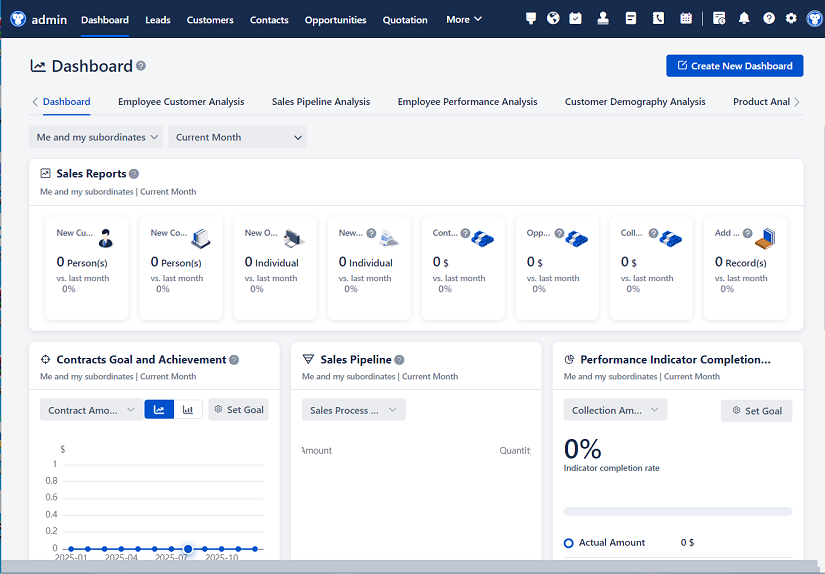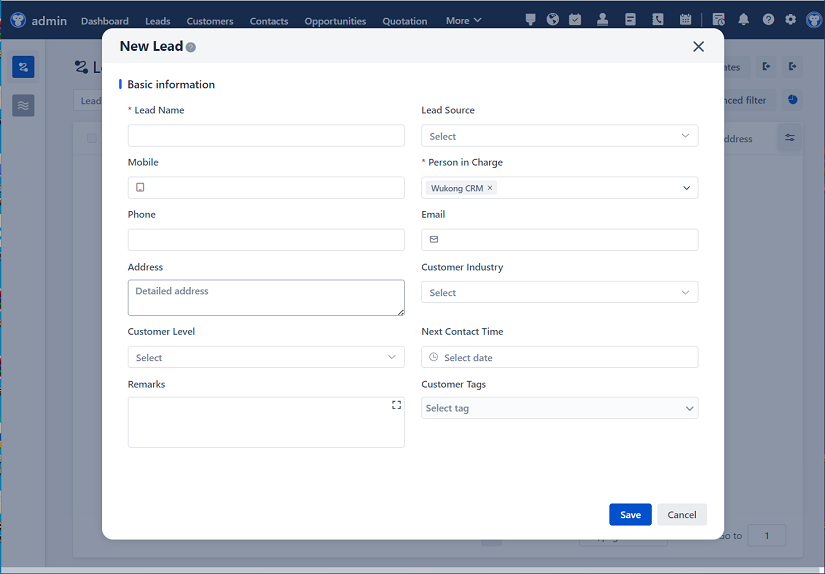
△Click on the top right corner to try Wukong CRM for free
So, let me tell you something—I’ve been diving deep into CRM software lately, and honestly, it’s kind of overwhelming. There are so many options out there, each claiming to be the best, and it’s hard to know which one actually fits your business needs. I mean, you’ve got Salesforce, HubSpot, Zoho, Microsoft Dynamics, Pipedrive—you name it. They all promise to streamline your sales, improve customer relationships, and boost productivity. But do they really deliver? That’s what I wanted to find out.
Let’s start with Salesforce because, well, it’s kind of the big dog in the CRM world. I’ve heard people say it’s powerful, and after spending a few weeks testing it, I can see why. It’s packed with features—lead management, opportunity tracking, forecasting, automation, analytics, the whole nine yards. But here’s the thing: it’s also kind of complex. Like, really complex. If you’re not tech-savvy or don’t have a dedicated IT team, getting up and running can feel like climbing a mountain. I spent two days just trying to figure out how to customize a dashboard, and I still didn’t get it right the first time.
But once you get past the learning curve, Salesforce is incredibly flexible. You can build custom workflows, integrate with hundreds of third-party apps, and scale it to fit a huge enterprise. It’s like having a Swiss Army knife for customer relationship management. The downside? It’s expensive. Like, really expensive. The basic plan starts at $25 per user per month, but once you start adding on features and users, the bill can skyrocket. So unless you’re a mid-sized or large company with deep pockets, it might not be the best fit.
Now, let’s talk about HubSpot. I actually really like HubSpot—it feels more user-friendly, you know? The interface is clean, intuitive, and doesn’t make you feel like you need a degree in software engineering to use it. It’s perfect for small to medium-sized businesses that want something straightforward but still powerful. One thing I love is how well it integrates marketing, sales, and service tools. You can track a lead from the first email click all the way through to a closed deal, and even follow up with customer support afterward. That kind of end-to-end visibility is huge.
HubSpot also has a free version, which is awesome for startups or teams on a tight budget. Sure, it’s limited—only 1,000 contacts, basic reporting, no automation—but it’s a great way to test the waters. And when you’re ready to upgrade, their paid plans are pretty reasonably priced. I was surprised at how much you get for $45 per user per month. Plus, their customer support is actually helpful. I called them once with a question about email tracking, and the rep walked me through it step by step. That kind of service makes a difference.
But HubSpot isn’t perfect. As your business grows, you might hit some limitations. For example, their automation rules aren’t as advanced as Salesforce’s, and if you need deep customization, you might feel restricted. Also, while the free version is great, upgrading can get pricey if you add on marketing or service hubs. So you’ve got to plan ahead and budget accordingly.
Then there’s Zoho CRM. I’ll be honest—I didn’t expect to like it as much as I did. It’s affordable, starting at just $14 per user per month, and it packs a serious punch for the price. It’s got all the basics: lead and contact management, sales forecasting, workflow automation, and even AI-powered insights through their Zia assistant. I found Zia to be surprisingly helpful—she can predict deal closures, suggest the next best action, and even detect sentiment in emails. It’s like having a tiny sales coach in your pocket.
What really impressed me about Zoho is how customizable it is without being overwhelming. You can tweak modules, create custom fields, and set up approval processes without needing a developer. And the integration with other Zoho apps—like Books, Campaigns, and Desk—is seamless. If you’re already using Zoho for accounting or email marketing, sticking with their CRM makes total sense.
That said, the interface feels a little outdated compared to HubSpot or Salesforce. It’s functional, sure, but not exactly sleek. And while their mobile app works, it’s not as polished as the others. Also, customer support can be hit or miss. I had to wait over 30 minutes on chat once, and the agent didn’t fully solve my issue. So if you value quick, reliable support, this might be a concern.
Now, Microsoft Dynamics 365—I’ve got mixed feelings about this one. On one hand, if your company is already deep in the Microsoft ecosystem (think Outlook, Teams, Excel), then Dynamics makes a ton of sense. It integrates beautifully with those tools, so your data flows smoothly across platforms. I loved being able to pull CRM data directly into Excel for analysis or schedule meetings from within the CRM using Outlook. That kind of seamless workflow is a game-changer for productivity.
The platform is also highly scalable and secure, which enterprise companies love. It’s got advanced AI features, real-time analytics, and strong compliance tools—perfect for regulated industries like finance or healthcare. But here’s the catch: it’s complicated and expensive. Setting it up requires serious technical know-how, and the licensing model is confusing. You’re not just paying per user—you’re paying for different modules, add-ons, and sometimes even per feature. By the time you’ve added everything you need, you could be spending hundreds per user per month.

And honestly, the user experience just isn’t as intuitive as HubSpot or even Zoho. It feels more like a corporate tool than a customer-focused platform. If you’re a small team without dedicated IT support, I’d think twice before jumping in.
Then there’s Pipedrive. This one’s interesting because it’s built specifically for sales teams. The whole interface is centered around the sales pipeline, with a visual drag-and-drop layout that makes it super easy to track deals. I actually found myself using it more consistently than the others because it felt so natural. You can see where each deal is stuck, set reminders, and prioritize follow-ups—all in one glance.
Pipedrive is also very affordable, starting at $14.90 per user per month. For startups or small sales teams, that’s a no-brainer. It’s got solid automation, email integration, and reporting tools. Plus, their mobile app is excellent—clean, fast, and fully functional. I used it on the go during client meetings, and it worked flawlessly.
But it’s not designed for marketing or customer service. If you need robust marketing automation or support ticketing, you’ll have to integrate third-party tools or switch to a different platform later. And while it’s great for managing deals, it lacks some of the deeper analytics and forecasting capabilities of Salesforce or Dynamics. So it’s ideal if you’re a sales-first company, but maybe not if you want an all-in-one solution.

So, after all this testing and comparing, what’s my takeaway? Well, there’s no one-size-fits-all CRM. It really depends on your business size, budget, team structure, and goals. If you’re a small startup, HubSpot or Pipedrive might be perfect. If you’re a growing company that needs flexibility and affordability, Zoho is a strong contender. And if you’re a large enterprise with complex needs and deep pockets, Salesforce or Dynamics could be worth the investment.
Another thing I realized is that integration matters a lot. No CRM exists in a vacuum. You want it to work well with your email, calendar, marketing tools, and maybe even your accounting software. So before choosing, think about your tech stack. Are you already using Google Workspace? Then HubSpot or Zoho might integrate better. Are you all-in on Microsoft? Then Dynamics makes sense.

Also, don’t underestimate the importance of user adoption. No matter how powerful a CRM is, it’s useless if your team doesn’t use it. That’s why ease of use and training matter. HubSpot and Pipedrive win here because they’re intuitive. Salesforce and Dynamics, not so much. You’ll need to invest time in training and change management.
And let’s talk about mobile access. These days, people are on the go. Sales reps are meeting clients, support teams are responding remotely, and managers are checking reports from their phones. A CRM with a clunky mobile app is a dealbreaker. From what I’ve seen, HubSpot, Pipedrive, and Zoho have the best mobile experiences.
Finally, customer support. I can’t stress this enough. When something goes wrong—and it will—you want to be able to get help quickly. HubSpot and Pipedrive were the most responsive in my experience. Salesforce has a massive knowledge base, but getting a real person on the phone can take time. Zoho and Dynamics were hit or miss.
So, after all this, what would I recommend? Honestly, I’d say start small. Try a free version—HubSpot’s free CRM is a great place to begin. See how your team responds. If you grow and need more features, you can upgrade or switch. Don’t overbuy at the start. It’s easy to get excited by all the bells and whistles, but you might not need them yet.
And whatever you do, involve your team in the decision. Talk to your sales reps, your marketers, your customer service folks. Ask them what they need. A CRM should make their lives easier, not harder. If it feels like extra work, it’s not the right fit.
FAQs (Frequently Asked Questions):
Q: Which CRM is best for small businesses?
A: I’d say HubSpot or Pipedrive. They’re affordable, easy to use, and have great free or low-cost plans. HubSpot is better if you want marketing tools too, while Pipedrive is ideal if you’re focused purely on sales.
Q: Is Salesforce worth the high cost?
A: It can be—if you’re a large company with complex needs. But for small or mid-sized businesses, it’s often overkill. The learning curve and price tag can be tough to justify unless you really need that level of customization and scalability.
Q: Can I switch CRMs later if I change my mind?
A: Yes, but it’s not always easy. Data migration can be tricky, and your team will need to relearn the system. That’s why I recommend starting with a flexible, low-risk option and upgrading only when necessary.
Q: Do all CRMs offer automation?
A: Most do, but the depth varies. HubSpot and Salesforce have strong automation; Pipedrive and Zoho offer solid basics. If automation is critical for your team, test it thoroughly before committing.
Q: Which CRM has the best mobile app?
A: In my experience, HubSpot and Pipedrive have the most user-friendly and reliable mobile apps. Zoho is decent, but Salesforce and Dynamics feel a bit clunky on mobile.
Q: How important is AI in a CRM?
A: It’s becoming more important. Features like predictive analytics, smart email suggestions, and automated data entry can save time. Zoho’s Zia and Salesforce’s Einstein are good examples. But AI isn’t essential for every business—especially smaller ones just starting out.
Related links:
Free trial of CRM
Understand CRM software
AI CRM Systems

△Click on the top right corner to try Wukong CRM for free